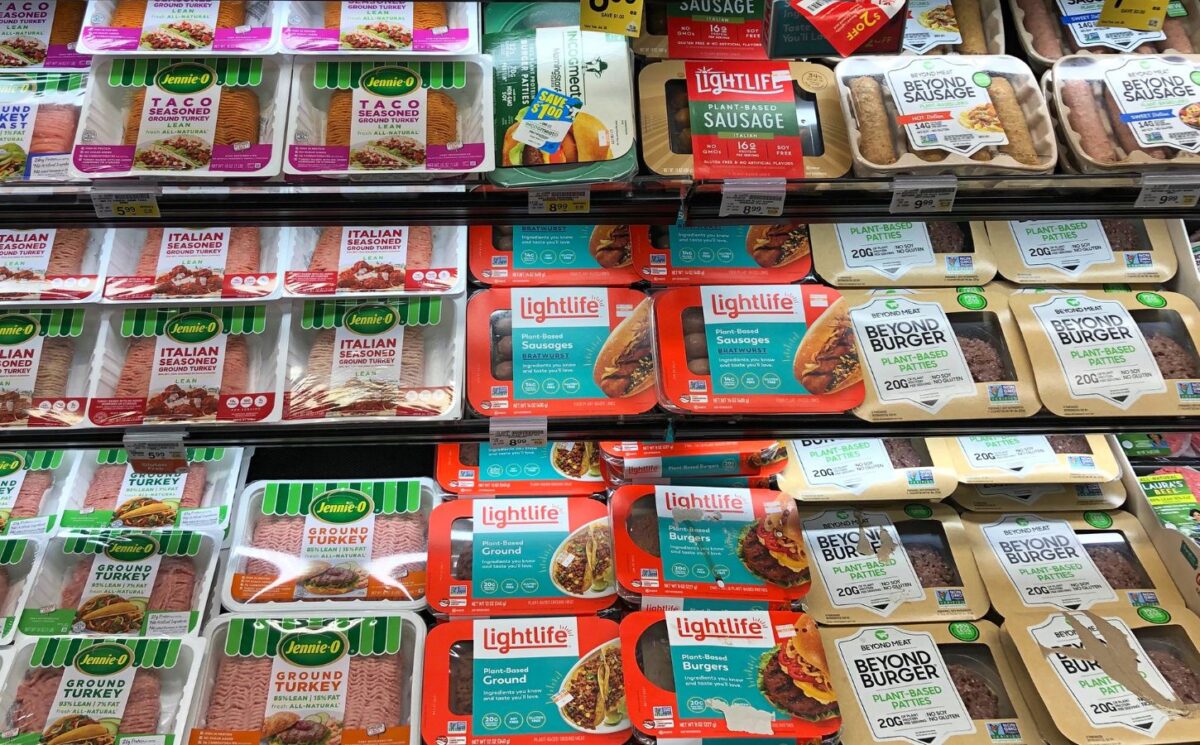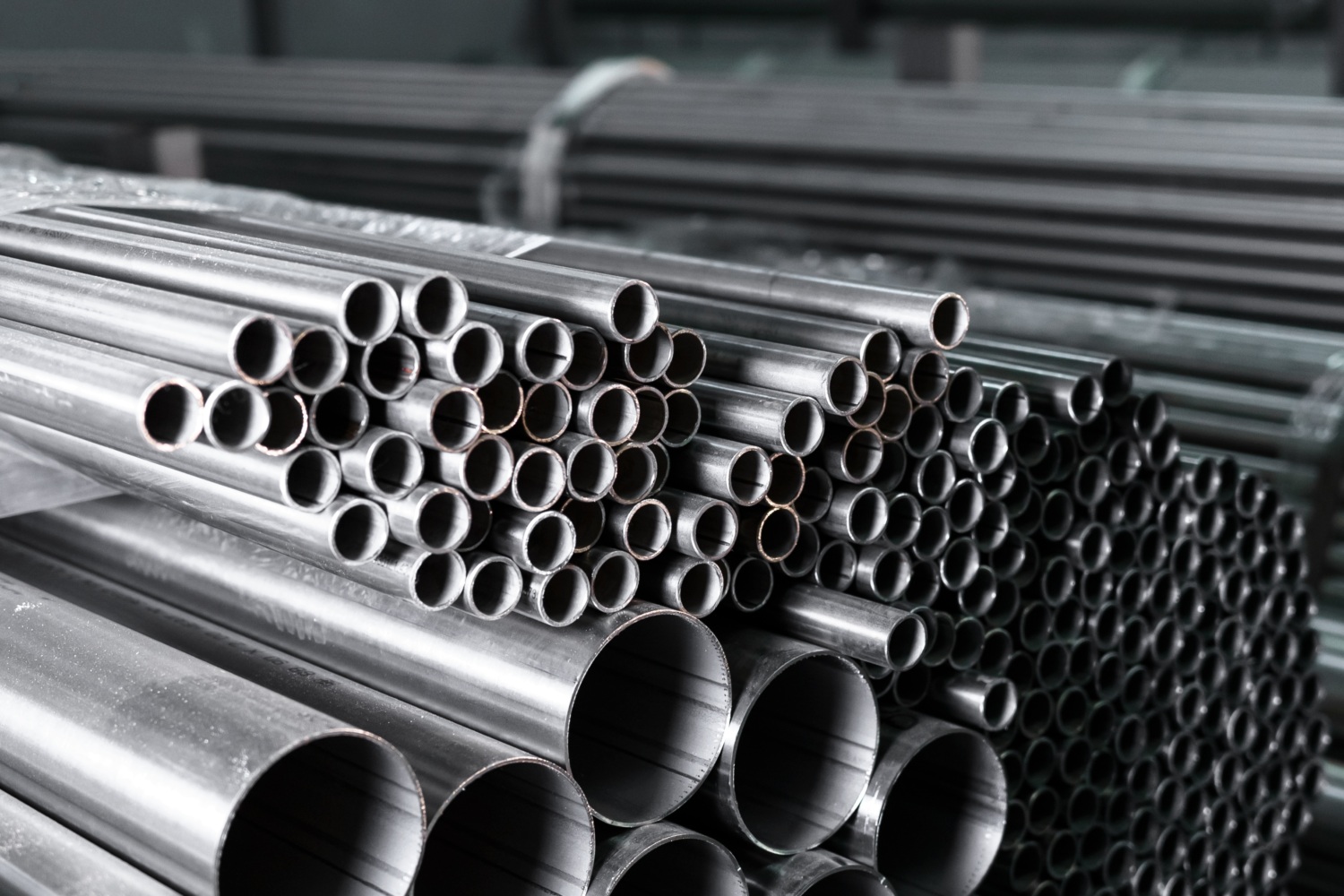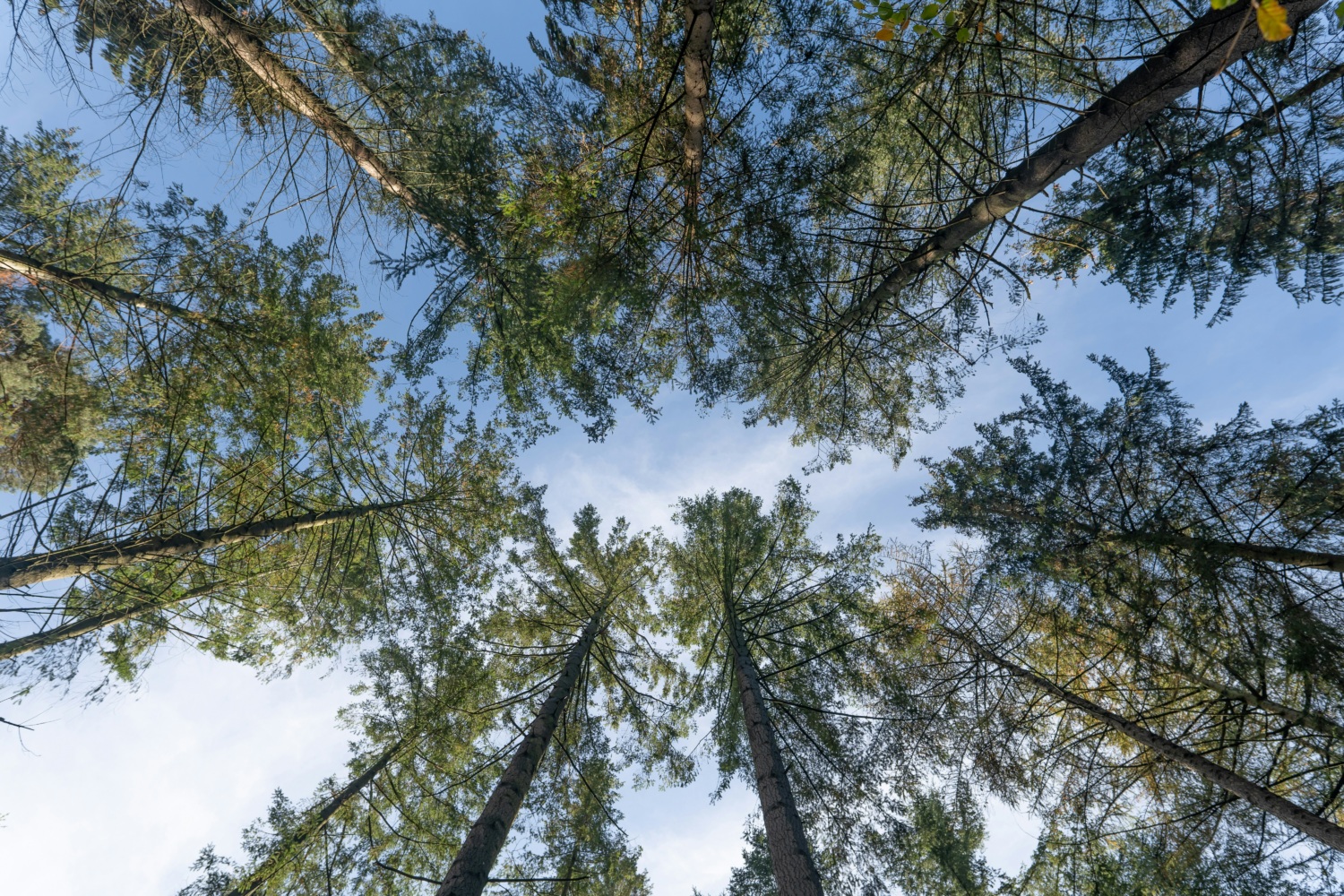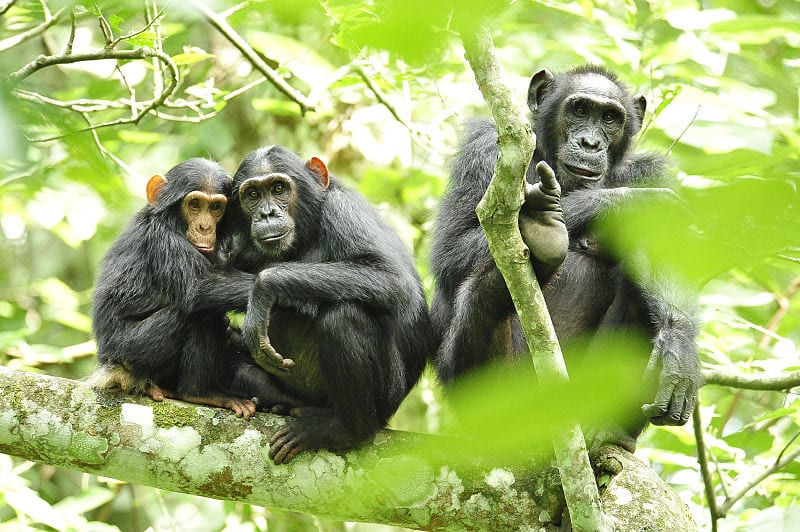
The Chocolate Crisis
Mighty Earth Research Reveals Massive Deforestation Connected to World’s Largest Chocolate Sellers
FrançaisBy Etelle Higonnet
Today, the world’s largest chocolate makers met with the Prince of Wales to discuss solutions to the chocolate industry’s biggest problem: the destruction of rainforests to make way for large-scale chocolate production. Companies including Olam, Mars, Mondelēz International, The Hershey Company, and Nestlé were at the table to see how they can take steps to ensure that customers don’t have to feel guilt for biting into their favorite brand of chocolate.
Deforestation for chocolate has ravaged forests in West Africa which are now at less than 18% their former size. With our global appetite for chocolate at an all-time high, we’re now seeing a race to expand cacao production, with plantations encroaching across Africa’s forests and in the Amazon rainforest, destroying chimpanzee and endangered animals’ habitats. Peru alone has seen a 5-fold increase in cacao (as the raw beans that produce cocoa and then chocolate are called) production between 1990 and 2013.
Mighty Earth just undertook a new mapping of tree cover loss from 2000-2014 in the chocolate producing regions of Ghana and Côte d’Ivoire, and found new evidence of massive deforestation.
-
- We found a total loss inside protected forest areas of 209,577 acres in Ghana and 1,196,879 acres in Côte d’Ivoire from 2000 to 2014, and additional loss in both countries outside those areas.
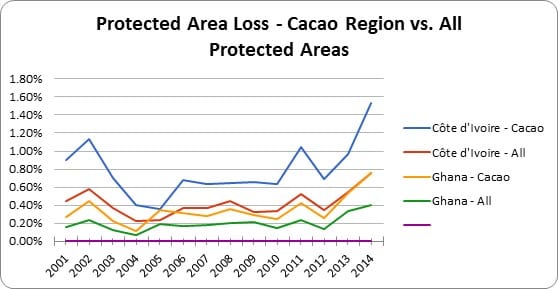
- Both legally protected forests and other forests are vanishing faster in cacao-producing regions than other regions. Deforestation of protected areas in the cacao-growing region was almost double what it is outside of cacao growing regions.
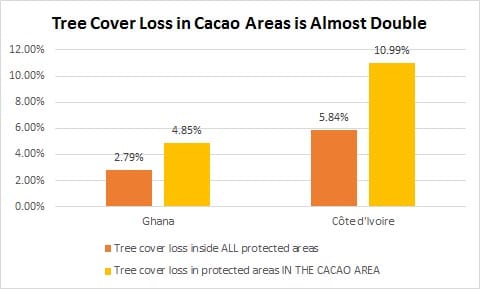
- In response to rising demand combined with too little attention to sourcing from major chocolate companies, the pace of deforestation in chocolate regions has worsened in both countries since 2004. Tree cover loss has been climbing especially alarmingly since 2012, until 2014 when the last maps were available.
- Côte d’Ivoire is losing its forests faster than any other nation in Africa. Ghana’s rate is alarmingly close.
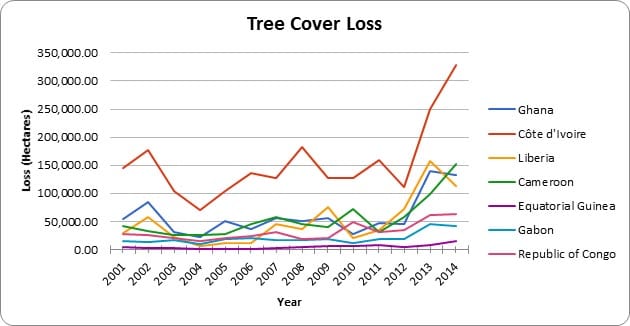
- Some of the deforestation is happening in the largest remaining chimpanzee habitats, particularly in Western Côte d’Ivoire and Southwest Ghana.
- In Ghana the non-protected forests are especially vulnerable – but even the “forest reserves” (with lower legal protection status) are being devastated relative to official “national parks” (with stronger legal status that makes them capable of resisting encroachments). In contrast, some of the most vulnerable areas in Côte d’Ivoire are actually within parks.
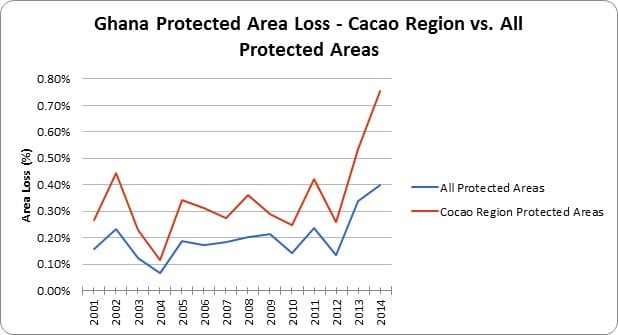
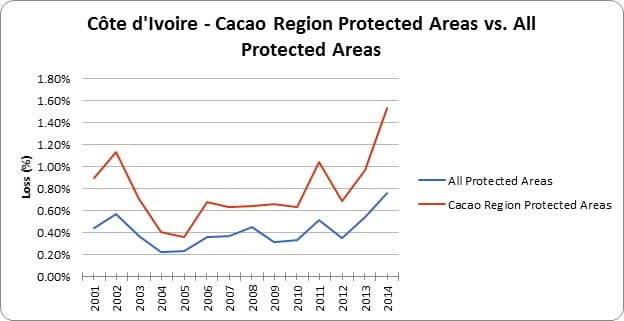
- We found a total loss inside protected forest areas of 209,577 acres in Ghana and 1,196,879 acres in Côte d’Ivoire from 2000 to 2014, and additional loss in both countries outside those areas.
We created an interactive map of deforestation across the entire cacao regions of Ghana and Côte d’Ivoire from 2000 to 2014; and we animated a zoomed-in time series of deforestation in two areas where cacao has driven deforestation in and around chimpanzee habitat. Our mapping provides incontrovertible visual evidence of what journalists, activists, and biologists on the ground have been saying: chocolate is killing West African forests and wildlife like chimpanzees on a massive scale.
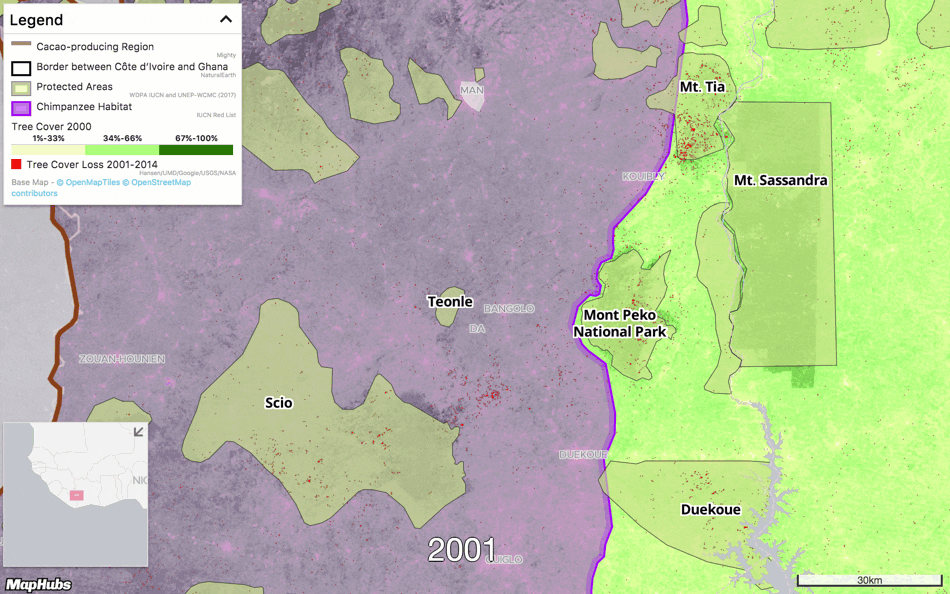
Before the chocolate industry’s insatiable hunger for new lands drives more deforestation, industry leaders must act. Chocolate makers should forthrightly address the chocolate industry’s dark past of forest destruction, embrace accountability, and adopt an industry-wide mechanism to eliminate deforestation (which has found success in the soy industry), for instance by focusing expansion only on Africa and other cacao-producing region’ millions of acres of degraded land. Other commodities like soy and palm have already signed on to similar sustainability reforms, whilst the chocolate industry is still busy greenwashing, delaying, and clearing thousands of hectares of carbon-rich, biodiverse forest in its quest for cheap new sources of chocolate.
The Prince of Wales has played a critical role many times in marshaling major companies and governments to take action for forests. Prince Charles’ involvement provides hope that chocolate lovers may soon be able to have more confidence that their favorite bar isn’t destroying great apes’ last West African habitat.

CONTEXT
- Chocolate global trends threaten forests: We consume close to 3 million tons of chocolate and other cacao products annually, but every year global demand goes up by about 2 to 5%, creating pressure on forests.
- Cacao has been a historical disaster for West African forests: Cacao production doubled from 1987-2007, causing deforestation, losses of biodiversity and high carbon emissions. (CIFOR). Cacao production is responsible for much of the loss of the rainforest of West Africa, a former global biodiversity hotspot, which shrank down to 18% of its original area by 2000. (Sustainability Science).
- Cacao is a disaster for Ivorian forests: The EU and the Ivoirian Forestry Ministry both estimated that about 80% of the country’s forests have disappeared from 1960 to 2010, much of it for cacao. An estimated 70% of illegal deforestation is related to planting cacao, and 12% of the country’s cacao is produced inside national parks. UNEP estimated 10,000 farmers had invaded the Western Cavally forest, one of the last protected areas in the country and which provides crucial habitat to chimpanzees and elephants. (The Chicago Council).
- Great apes are disappearing: “Researchers surveying primates in 23 protected areas in Côte d’Ivoire encountered scenes of destruction nearly everywhere: illegal cacao farms had encroached on two thirds of the areas studied, causing a dramatic collapse of primate populations” like the Roloway monkey, and chimpanzees. (Rainforest Rescue).
- Cacao is becoming a driver of Deforestation in the DRC: A study in the Democratic Republic of the Congo on the four major cacao growing regions “found that cacao expansion could lead to the loss of 176-395 square kilometres of forest in the next decade”, especially in Mambasa, Equatorial Province, Mbandaka, Bikoro and Lukolela.
- Cacao is threatening the Amazon rainforest too: Cacao producers have now turned to South America, especially Peru, which has seen a nearly five-fold increase in cacao production between 1990 and 2013. Satellite images in 2012 showed United Cacao deforesting 2,000 hectares (nearly 5,000 acres) for a cacao plantation, encroaching dramatically on the carbon-rich, biodiverse Amazon rainforest in Peru. “Matt Finer of the Amazon Conservation Association used Landsat imagery to chronicle the clearing month-by-month and prove that the area was previously primary forest. Meanwhile, Greg Asner of Stanford University’s Carnegie Institution for Science used airborne LiDAR technology to estimate that the patch of forest contained an average of 122 metric tons of carbon per hectare (54.4 tons per acre).” (WRI).
- The emissions of one chocolate bar: “Cadbury estimates that 169g of carbon dioxide equivalent are emitted into the atmosphere for each 49g Dairy Milk chocolate bar,” not counting emissions from deforestation. But if the same milk chocolate bar were made from ‘deforestation cacao’ like United Cacao’s in Peru, it would have nearly double the carbon footprint, and a dark chocolate bar would have triple the climate impact. (WRI).
- Cacao drives deforestation and labor abuse in similar ways: The global market for cacao was around $100 billion in 2015, and top chocolate companies make sizeable profits but insist on ever lower costs, driving illegality both in their quest for cheap labor (including child labor) and cheap land (including forests). Cacao employs 5-6 million farmers, mostly smallholders living on under $1.25/day. Most cacao farmers in Côte d’Ivoire and Ghana earn roughly $0.54 and $0.82 per day cultivating the crop. The chocolate industry is notorious for labor rights abuses, highlighted by campaigns like the video “Hershey’s Chocolate, Kissed by Child Labor.” A 2015 report by the U.S. Department of Labor found that, “21 percent more children are illegally laboring on cacao farms in Ghana and Côte d’Ivoire than five years ago.”
- The cacao sector can reform and commit to true responsible production: The industry is far from any sustainability commitments seen from leaders in the palm oil and paper industries or in the Brazil soy moratorium. The chocolate industry is not even close to addressing illegal and legal deforestation, the decimation of national parks, illegal cross-border sales, slavery, child labor, land-grabbing, and pauperization of vulnerable smallholders. But they can change. What is needed is the political will for the industry to turn the corner, and bring together companies like Mars, Nestle, and Mondelez; Cargill, Barry Callebaut, and Dreyfus, Olam, alongside the governments of Côte d’Ivoire and Ghana, and international/regional banks.
